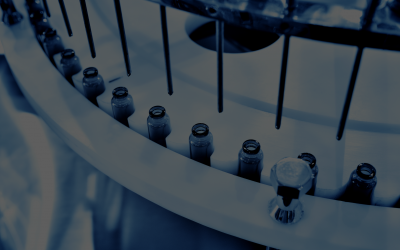Understanding the properties of glass and the ability to measure strength (impact resistance) is essential to safe handling protocols that promote efficiency, drug container performance and ultimately, lower risk of failure.
Why glass pharmaceutical containers are susceptible to breakage:
As is the case with other fragile materials, glass strength is heavily dependent on its damage condition. Not a material constant, the strength of glass is determined by existing surface quality and the criticality of surface defects.
In fact, pristine glass has an impressive theoretical tensile strength of 50-90GPa. However, if that same pristine glass is scratched against metal or glass, or has an inclusion, its resistance will drop dramatically. The important conclusion here is to understand that glass doesn’t have a specific strength value.

Any given container’s resistance to breakage during processing is heavily dependent on both preexisting surface quality defects and mechanical force that is applied to that container.
The causes of surface degradation on glass pharmaceutical containers are varied and numerous:
- Defects accrued during heat treatment, ie: depyrogenation oven or annealing processes
- Mechanical force from contact (ie: glass-to-glass or glass-to-metal) during processing or transportation
- Chemical wash or other sterilization processes
- Relative humidity during storage
In pharmaceutical applications, this damage can occur at many points in the value chain.
To accurately measure glass strength, we can look to a number of methods, some more effective than others.
Measuring the impact resistance of a glass pharmaceutical container.
Relative to glass containers, impact resistance measurement is more complex as compared to internal pressure, which is repeatable, measurable and easily controlled.
“Various strengths exist for different parts of the container. Also, strengths for momentary loading, such as for impacts during handling, are significantly different than those for long sustained loads,” explains Kiy L. Yam in the Wiley Encyclopedia of Packaging Technology.
Until the development of in-line sensor technology, impact measurement was a static measurement generated using a destructive testing method. The advent of in-line sensor technology has enabled additional methods of measuring impact resistance using a more dynamic calculation of impact magnitude.
A non-destructive testing method, smart in-line sensors are fitted into an equivalent replica of a glass vial or container. The smart sensor measures variables during processing in a manner that’s directly equivalent to how containers being processed experience force.
This method and ability to generate an impact rating for any given glass container, means that packaging engineers and filling line technicians can understand how a container will perform (by way of a given percentage of breakage) when it is impacted by a known mass.
Impact is a damaging mechanical load when processing glass containers. Of course, it isn’t a guarantee that breakage will occur simply because a bottle receives a given impact; however, the probability of breakage absolutely does increase.
A weighted sum approach to Fill and Finish line impact performance.
In order to determine the probability of glass maintaining its integrity under a certain stress, Weibull distribution is the most widely employed in the different research papers covering glass strength topics.
Taking into account that stress is proportional to impact speed, our experience and that of our partners, having impacting several thousands of containers and extensive mathematical calculations, allows us to effectively calculate the probability of failure for any combination of low-level impacts of varying intensity.
Given that during the Fill and Finish process, containers receive multiple impacts of varying severity, it is difficult to provide an overall result or even to compare different filling lines. The risk of breakage greatly depends on impact magnitude, so individual impacts cannot simply be added together.
A weighted sum approach is important to understanding the cumulative impact performance of a given line or process. In-line sensors can generate a single number representing the severity of the impacts received throughout the whole filling line or within a portion of it.
The use of smart in-line sensors brings visibility of vulnerable points, be it impacts causing glass particulates, or damage and breakage. Identifying precise areas of impact measured in g-force, as well as a line’s overall impact rating, allows for precise calibration and data driven decisions.






